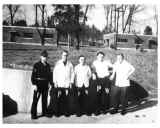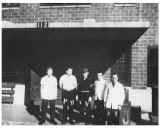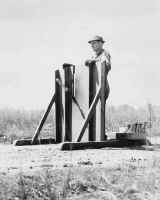1944
|
1944 In every practicable instance, women employees were substituted for men. An innovation in this policy was the hiring of black women as laborers. Previously, only black men had been employed. |
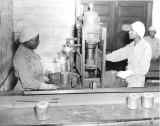
|
|
1944 Because of the continued difficulty in recruiting adequate numbers of skilled and unskilled workers, the War Manpower Commission, with the help of Redstone Arsenal officials, implemented an extensive campaign to attract applicants. Handbills, sound trucks, newspaper advertisements, and displays of ammunition manufactured at the arsenal were used in the campaign. February 1944 Production of the M-3 and M-4 colored smoke canisters to be assembled by Redstone Arsenal, began at Huntsville Arsenal. The buildings used in this manufacturing process were scattered over a 12-acre area as a double precaution against fire, explosions, or enemy attack. Production of these canisters continued until April 1945. 11 February 1944 Production of phosgene, a toxic agent, began at Huntsville Arsenal. It continued until 17 January 1945. Filling of 500-pound M-78 bombs lasted from 15 to 27 April 1944, while filling of 1000-pound M-79 bombs was accomplished between 28 April 1944 and 17 January 1945. This effort was discontinued on 17 January 1945, after all the phosgene made and stored at this facility had been filled into bombs. |
|
26 February 1944 Redstone Arsenal acquired new rank when its Commanding Officer, Carroll D. Hudson was promoted to full colonel. |
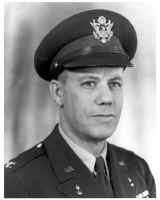
|
|
March 1944 The highest dollar value of production at Huntsville Arsenal was reached during this month, when a total of over $5.7 million was produced. The reason for this peak was not the fact that maximum work was done, but that the large output of an expensive item-the M-69 bomb-added considerable dollar value to the month's total. 10 March 1944 Operations for the production of the M-6 tear gas grenade began at Huntsville Arsenal and were completed on schedule on 23 May 1944. A total of 252,348 of these grenades were manufactured. 14 March 1944 Huntsville Arsenal began producing the M-22 (T8E1) rifle grenade. Manufacture of this munition continued until the end of the war. 29 March 1944 2LT Eleanor B. Wilson was the first member of the Women's Army Corps to be assigned to Redstone Arsenal. She was temporarily assigned from the Fourth Service Command to assist in Signal Corps work. April 1944 Production of the M-4A2 floating smoke pot began at Huntsville Arsenal. This item replaced the M-4 pots that had been completely discontinued after several improvements were made to the munition. 27 April 1944 A second serious production line explosion occurred at Redstone Arsenal, killing one woman and severely injuring two other employees. |
|
May 1944 Huntsville Arsenal's civilian personnel reached a peak of 6,707. June 1944 Huntsville Arsenal's refuzing program began and continued sporadically until July 1945. Because the M-200 fuzes used in hand grenades produced before July 1944 were not waterproof, the percentage of duds was excessive. The munitions were returned to Huntsville Arsenal for installation of an improved fuze (M-201). The crew used for refusing grenades had been trained previously to produce M-8 and M-18 grenades, and the new operation was essentially the same. Women were used on a majority of the line operations, although men were required for strenuous work and heavy lifting. |
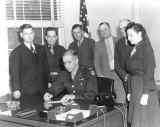 Huntsville Arsenal Staff, 1944 |
 Advertisement in Huntsville Times for people to come to work at Redstone Arsenal< |
 Loading ordnance on railcars |
|
June 1944 The M-88 smoke shell measured 75mm in diameter and was designed to be fired from an artillery weapon. The principal munition of smoke took place after the shell reached the target, at which time it functioned as a smoke grenade or a small smoke pot. Production of this munition began at Huntsville Arsenal during this month. The work on this shell was largely a repetition of that done earlier on the M-89 smoke shell. Production of the M-88 ceased in November 1944. July 1944 Redstone Arsenal was designated the official center for the screening and renovation of chemical artillery ammunition returned from overseas (ARFO) and from depots in the United States. The actual renovation of complete rounds of ARFO began in January 1945 and continued until V-J Day in September 1945. 4 July 1944 Redstone Arsenal participated in the Town Meeting for War at the Madison County Fair Grounds. The arsenal's products, including smoke shells; colored canisters; colored rifle grenades; and demolition blocks, were spectacularly demonstrated for the public. August 1944 Redstone Arsenal submitted an extensive mechanization program for approval by higher headquarters. The project involved the reconstruction, alteration, and addition of equipment for all production lines and the ARFO renovation line. As a result, arsenal officials expected to meet greatly increased production schedules with minimum personnel requirements. 25 August 1944 An "Employees' Welfare Association" was organized to contribute to the welfare, comfort, pleasure, contentment, and mental and physical improvement of Redstone Arsenal employees. September 1944 Conferences were held with representatives of the Federal Works Agency concerning the establishment of a nursery to care for Redstone employees' children. October 1944 The Ordnance Department designated Huntsville Arsenal as a key supply point for requisitioning, storing, and issuing automotive spare parts and supplies. Redstone Arsenal, the Resident Engineer at Redstone Arsenal, the Gulf Chemical Warfare Depot, Courtland (Alabama) Air Base, and the Gulf Ordnance Works at Aberdeen, Mississippi, drew on Huntsville Arsenal for their supplies. November 1944 To meet escalating requirements for ammunition, the Secretary of War approved a $500,000 project for the mechanization of Redstone Arsenal's production facilities. The purpose of this project was to increase the capacity and efficiency of manufacturing operations involved in the loading and assembling of ammunition, while reducing manpower requirements. |
The Pre-Missile Era:
Introduction,
1941
,
1942
,
1943
,
1944
,
1945
,
1946 & 1947,
1948 & 1949
